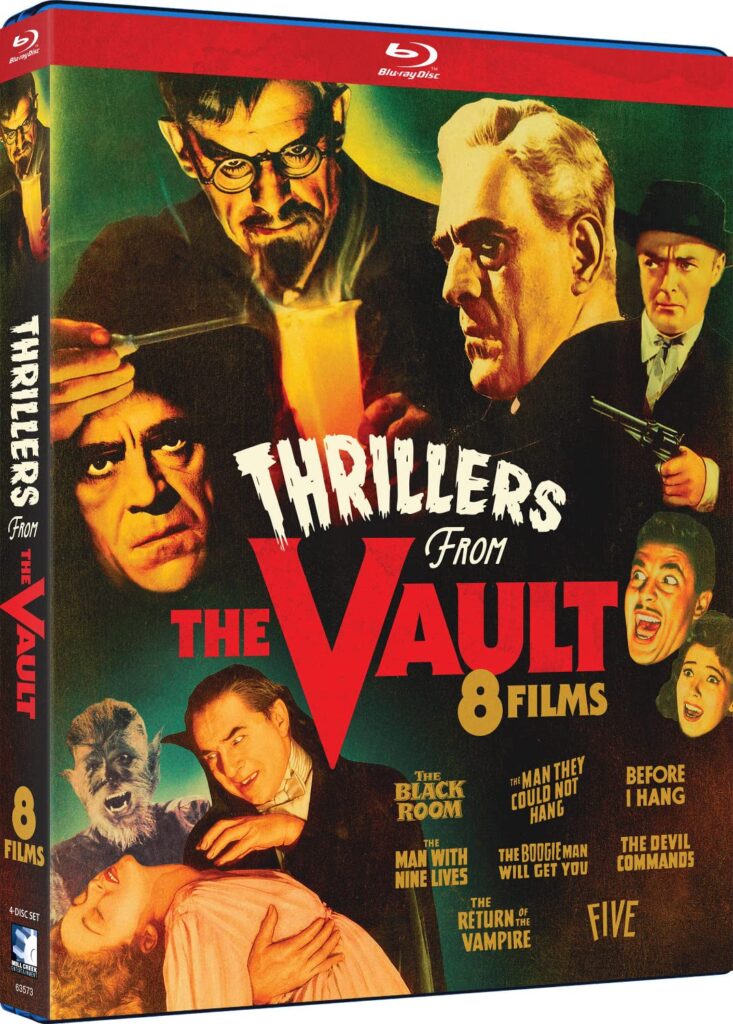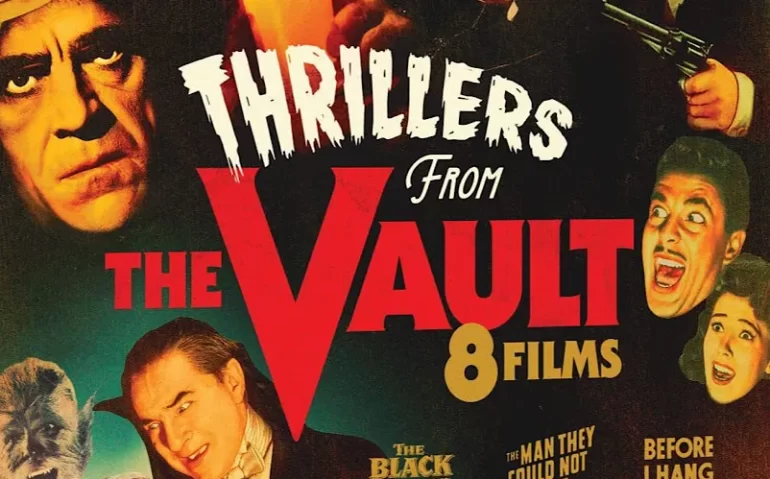Verdict
Summary
Mill Creek’s 8-film collection here are all well handled with nice transfers (some unavoidable scratching in some of the prints don’t harm the viewing experience), and while they might’ve just done a 6-film Karloff set, the addition of Lugosi’s Return of the Vampire and the post-apocalyptic Five feel like odd bonuses.
The Black Room (1935) Plot:
Twin brothers – one good and one evil – vie for the lordship of a castle, their birthright.
Review:
Twin brothers are born, portending a prophecy that declares that the bloodline will end with them when one of them will eventually murder the other, both of them unmarried. As they grow up, Anton (Boris Karloff) is the good, just brother, but with one arm paralyzed, with his twin brother Gregor (also Karloff) the cruel hearted of the pair. When he’s older, Anton moves away to seek a life for himself, leaving Gregor the lord of castle, but the entire estate and the lands around belong to Anton, as he is the firstborn, which is a thorn in the evil Gregor’s side. People in the villages around fear and despise Gregor (he’s even cruel to dogs), and when Anton makes a surprise return home for a visit after being away for years, everyone is confused and shocked when they realize that Anton is Gregor’s better twin brother. When the townsfolk is just about to run Gregor out of town with their hatred of him, Anton steps in and shows mercy, and Anton even has time to woo a damsel, but before he can marry her, Gregor secretly murders him and dumps his body in a pit in a secret “black room” in the castle that no one knows about and assumes his identity, which means he’ll have to pretend he’s crippled in one hand for the rest of his life, never slipping up even for one moment. But just as he’s about to make the illusion complete by marrying Anton’s woman, Gregor breaks the illusion in front of the whole village in a crucial moment, sealing his fate.
From director Roy William Neill, the satisfying dark thriller The Black Room gives Boris Karloff a juicy double role, and the movie even figures out a way for him to be one screen as both brothers a couple of times in a clever bit of film splicing. The movie works as a macabre horror film in the style of Poe, but it also works as a straight thriller set hundreds of years in the past. With good sets, solid performances, and good direction, this one still plays well to modern sensibilities.
Five (1951) Plot:
A few people encounter each other after the nuclear apocalypse.
Review:
If you think On the Beach was the first of its kind, look here. Made soon after WWII, when movies were generally optimistic and cheery, Five begins with a realistic explosion (not stock footage) of an atomic blast, and the United States is nothing but a vacant and dead place, with an eerie silence that settles over everything. A pregnant woman somehow managed to survive the blast, and she staggers over a few hills and plains until she comes across a homestead presided over by a bearded farmer who also survived the apocalypse. She takes shelter with him and they avoid radiation for awhile. Later, a car drives up, and an older man and a black gentleman get out and ask for help. The four of them manage to coexist peacefully for a time and even begin farming. The farmer’s lust for the pregnant woman gets the better of him at one point and he tries raping her. When she learns to trust him again, another man (a foreigner) is washed ashore on the beach and they find him and nurse him back to health. This man was an explorer and traveled by boat from country to country and found nothing but vacant wastelands wherever he went. The old man dies of radiation poisoning at this point, and the explorer steps up as the alpha male and picks fights with the black man because of his race. The farmer’s affections toward the woman heightens when she has her baby, but the explorer tricks her into going away with him to search for her husband in the city (he kills the black man before they leave), and he basically plans to use her as his slave, but when she finds her husband’s dead body, she runs away from her captor. When he catches up to her, she rips his shirt and he discovers that he has radiation poisoning too. He runs off in shame and she is left alone. She spends weeks trying to get back to the farm, but her baby dies in the meantime. The farmer finds her half-dead on the side of the road, and he takes her home, telling her that they’ll begin again together.
Instead of preaching to the choir about the perils of nuclear war, this movie, written and directed by Arch Oboler, is straightforward survival cinema, with characters who are not caricatures or puppets according to the plot. They go through the motions of dealing with the end of the world, and they die off one by one. They don’t sit around and share their feelings or question their predicament; they accept their fate and move forward. It’s a sobering little movie that will surprise you. Two interesting tidbits: a newspaper stand in the city has a headline that is never discussed by any of the characters, “Savant predicts the end of the world!” which would have been fun to learn more about, and second, the dead people strewn about the city are merely skeleton props, which lessens the impact of the reality the filmmakers are trying to convey, but it’s a minor detail. With William Phipps, Susan Douglas, James Anderson, Charles Lampkin, and Earl Lee.
The Boogie Man Will Get You (1942) Plot:
A hotel is host to shenanigans involving a mad scientist, an insane fraudster, and the unlucky couple who purchased the hotel.
Review:
A young couple thinks buying an old hotel is a good investment, and they plan on flipping it on the real estate market as soon as possible, but what they didn’t count on was that a mad scientist (played by Boris Karloff with a wink and a smile) is living and performing experiments in the basement. The scientist is intent on creating a super man out of dead bodies, which means that the bottom level is full of bodies, and where they come from and who they were is anybody’s guess. Add to the mix a fraudster (played by Peter Lorre) who might’ve recently escaped from an insane asylum, and the hotel becomes a grab bag of weird and goofy characters who all but ensure that the young couple will have a heck of a time selling the hotel in time to make a profit.
Billed as a thriller, but more of a comedy in the vein of a spooky Three Stooges two-reeler, The Boogie Man Will Get You is an uneven mixture of lame duck spoofery and spooky theater shenanigans. It doesn’t really work, but Karloff completists may appreciate it more than others.
The Man They Could Not Hang (1939) Plot:
A scientist is found guilty of murder by a jury, and after being executed, he comes back three months later to get revenge.
Review:
A doctor (played by Boris Karloff) who swears that he’s cracked the code to keep death at bay forever makes a deal with a man who gives his permission to be euthanized, but then resurrected, but when the doc kills him, the police show up and arrest him before he can finish the experiment. The doc is put on trial for murder and is found guilty by a jury and is sentenced to death by hanging. Before he’s executed, the doctor curses the judge, the jury, the police, and the prosecutor for stopping science and the great works he was meant to achieve, and three months later he’s brought back to life by his assistant who uses his notes to complete his work. The doc plans an elaborate revenge: he invites all those who were responsible for his execution, locks them in a house, and booby traps the place and forces them to face him before he kills them all one by one. Before the night is over, there will be a few surprises.
Ahead of its time for being somewhat of a torture porn / escape room / Saw type thriller, The Man They Could Not Hang has an unrepentant antagonist who never apologizes for his sadistic methods of torture and revenge. Characters are electrocuted, stabbed in the brain with hidden syringes, shot to death, and hung, and while that sounds extreme … it’s because it is! This is a tight little thriller and has aged well, considering it’s more than 80 years old! Directed by Nick Grinde.
The Return of the Vampire (1943) Plot:
A vampire returns to London to wreak havoc.
Review:
During World War II, a bomb is dropped on a London graveyard, unearthing Armand Tesla (Bela Lugosi), an impaled vampire long buried and forgotten. When the suave vampire starts integrating himself into society again, he also brings with him a werewolf named Andreas (Matt Willis) who will do his bidding no matter what. The werewolf causes quite a stir within the area as the police force has no idea how to deal with it, but Tesla’s return has its own chaotic consequences as the vampire sets his sights on a respectable young woman of society.
Somewhat of a belated sequel to the original Dracula, The Return of the Vampire is atmospheric with good, committed performances and great makeup effects (the werewolf is impressive), and fans of Lugosi should appreciate it as he basically does Dracula again, but with less intensity and nuance. Lugosi doesn’t show up for at least 15 minutes into the picture, though, but when he appears he commands the screen. From director Lew Landers.
The Man With Nine Lives (1940) Plot:
A doctor on the cusp of a medical marvel breakthrough seeks out the first doctor who experimented with the same theory.
Review:
On the cutting edge of frozen therapy, Dr. Tim Mason (Roger Pryor) is considered too radical by his superiors, and he’s given a leave of absence, and instead of just sitting around waiting for someone else to use his theories in medicine, he and his assistant (Jo Anne Sayers) travel to a remote area where a long lost doctor named Kravaal (Boris Karloff) used to practice the same theories, but disappeared 10 years ago. When Mason and his assistant find Kravaal encased in ice in his subterranean lab, they thaw him out and revive him. Alive again and eager to continue his research with Mason’s help, Kravaal is revealed to have frozen a handful of others 10 years ago, men who threatened to incarcerate him for what they believed was murder, but was in fact just another of his risky experiments. When Mason realizes that Kravaal is unstable and willing to actually commit murder to save his research, he and the other newly revived men have to figure out how to outsmart the crazed doctor before he kills them all in the name of science.
Similar to the previous year’s The Man They Could Not Hang (also with Karloff in a strikingly similar role), The Man With Nine Lives offers another mad scientist plot, but this one involving ice and freezing patients, which seems to have been a bit ahead of its time, now that they do this for real when performing surgery on heart patients. The film gives Karloff another juicy antagonist / protagonist role to sink his teeth into, and the film works on the whole as a dramatic thriller. From director Nick Grinde.
Before I Hang (1940) Plot:
A doctor guilty of a mercy killing is sentenced to death, and while in prison, he figures out how to rejuvenate himself and grow younger … but with consequences.
Review:
Sentenced to death by a jury for a mercy killing, Dr. John Garth (Boris Karloff) exhibits exceedingly good behavior on death row, impressing the warden, who believes Garth’s claims that his crime wasn’t worthy of the death penalty. Rewarding Garth with unprecedented access to a medical laboratory while he’s awaiting the date of his execution, the warden affords Garth a great deal of freedom while in prison. On the day of his scheduled execution, Garth perfects an experimental serum, which he injects himself with, but everyone is in for a surprise: the governor grants clemency to Garth and takes him off death row, allowing him to serve life in prison instead. The serum that Garth injected himself with contained the blood of a serial murderer, and over time he grows increasingly sinister and eventually murders a doctor working with him in his lab, but fate intervenes and the killing is blamed on another inmate, whom Garth also kills in a scuffle. The warden completely buys into the probability that Garth was a victim, and then the media and the public demands Garth’s complete vindication and exoneration, and so his conviction is overturned and he’s released. When Garth tries integrating into society again, he does so with the murderous, sinister intent running in his blood, and he kills again … and again, until he realizes that something must be done about it, even if he must turn himself in to protect society at large.
A solid dramatic thriller with a well cast Karloff in a role he slips right into, Before I Hang was one of a string of films he collaborated with filmmaker Nick Grinde. The two of them made similar films such as The Man With Nine Lives and The Man They Could Not Hang, all of which feature Karloff in a mad scientist role with very similar themes. This one is pretty solid, and fans of the star will not be disappointed.
The Devil Commands (1941) Plot:
A grieving scientist tries communicating with his dead wife with the help of a medium … and science!
Review:
A scientist (played by Boris Karloff) has a bright career with a loving family, but his wife is killed in a random accident, leaving him reeling with inconsolable grief. By chance, one of his experiments with electricity suggests that his dead wife’s brain might still be transmitting signals, and so he visits a spirit medium to see if there’s anything to the theory of life after death. He immediately sees right through the medium’s fake methods, but instead of debunking her, he enlists her help in being his assistant in furthering his experiments, which proves to be a good union … except when he kills someone during an experiment. Police get involved, but he manages to avoid arrest, continuing with his weird experiments with the medium. Soon, his experiments go too far, and more people end up dying, and so his fate is sealed.
A little more of a slow burn than some of the other similar Karloff mad scientist movies included in this set, The Devil Commands has a usually convicting performance by Karloff, and I enjoyed the angle of mixing spiritualism with science, but the movie is not quite as engaging with its plot as it might’ve been. It definitely falls into the “thriller” category, though, so it’s correctly placed in this set.
Mill Creek’s 8-film collection here are all well handled with nice transfers (some unavoidable scratching in some of the prints don’t harm the viewing experience), and while they might’ve just done a 6-film Karloff set, the addition of Lugosi’s Return of the Vampire and the post-apocalyptic Five feel like odd bonuses. There are four discs, with two films per disc. There are commentaries on a handful of the films, plus a special feature entitled “Madness and Mayhem: Horror in the 30s and 40s.”



